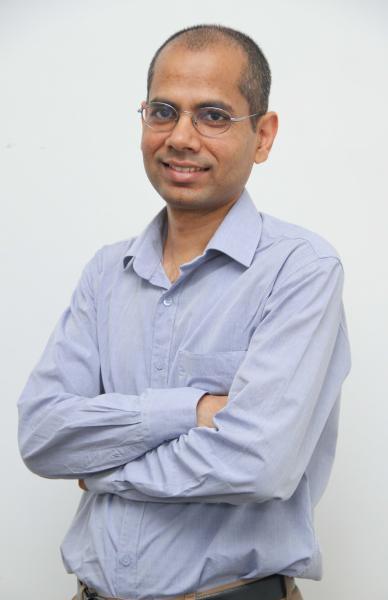
Prof. Mani Bhushan
Core Faculty,
Professor,
Chemical Engineering,
Indian Institute of Technology Bombay

Prof. Mani Bhushan is a Professor in the Department of Chemical Engineering at the Indian Institute of Technology (IIT) Bombay. He is also associate faculty at Centre for Machine Intelligence and Data Science (CMInDS). He received his B.Tech. and Ph.D. from IIT Bombay, followed by postdoctoral research at Purdue University and a faculty position at the University of Alberta, Canada.
Prof. Bhushan’s research lies at the intersection of Process Systems Engineering, modeling, and advanced control, making his work highly relevant to the themes of ECM 2025. His contributions to sensor network design have enabled more efficient and fault-resilient monitoring in large-scale systems through graph-theoretic and optimization-based techniques. This work informs both energy-intensive industrial processes and the development of smart monitoring infrastructures.
In the field of nonlinear state estimation, Prof. Bhushan has developed deterministic sampling-based methods—such as constrained unscented Kalman filters and Gaussian sum filters—that improve the reliability of real-time data interpretation in complex, constrained environments.
His collaborative projects include real-time diagnostics of self-powered neutron detectors in nuclear reactors, where he applies data-driven approaches like clustering and principal component analysis for fault detection and flux estimation, and deployment of machine learning approaches for safe refinery operations—core areas aligned with ECM’s emphasis on control and diagnostics in energy systems. His work also extends to environmental systems, using machine learning to study aerosol impacts on monsoon dynamics.
A recipient of the IIT Bombay Young Investigator Award and IUSSTF fellowship, Prof. Bhushan continues to influence academia and industry alike through his systems-oriented approach to energy and control challenges.
Title: Modelling, Simulation and Control of Solar Power Plant
Amongst various renewable energy options, solar energy stands out as a promising option due to its vast availability and potential to meet large-scale energy demands. Unlike fossil fuels, which are geographically limited and polluting, solar energy is available almost everywhere and can be harnessed without adverse environmental impacts. In the field of solar energy, two primary technologies prevail: solar Photovoltaic (PV) and solar thermal. Among solar thermal systems, Concentrated Solar Power (CSP) stands out as a key method for generating electricity. While PV systems convert sunlight directly into electricity using semiconductor materials, Solar Thermal Power Plants (STPPs), which operate using CSP technology, harness focused sunlight to generate the high temperatures needed to produce steam and drive turbines for electricity generation. Among the various solar thermal configurations, technologies such as Parabolic Trough Collectors (PTC), Linear Fresnel Reflectors (LFR), solar power towers, and solar dish systems are commonly adopted and tailored for specific applications based on efficiency, scale, and site requirements. Solar thermal plants can also be integrated with thermal energy storage using technologies like molten salt tanks, which enables electricity generation even during periods without sunlight, such as nighttime or cloudy weather.
Despite its potential, efficient and economically viable operation of an STPP is challenging. These challenges stem from significant diurnal and seasonal variations of available solar insolation, as well as of power demand and electricity tariffs. Designing and operating a plant efficiently in presence of these variations is a challenging task. Availability of a detailed dynamic model can significantly aide in this exercise. Such a model can be used not only for real-time optimization and control, but also for simulation-based design studies. Designing and operating a plant without a model-based simulation exercise, might be inefficient and even potentially unsafe.
In this talk, we present our recent work on development of a dynamic model and its use in design, control, optimization, and operation of a 1 MWe Hybrid Solar Thermal Power Plant (HSTPP). The plant integrates two types of CSP technologies namely PTC and LFR, along with key subsystems such as heat exchangers, Thermal Energy Storage (TES), a steam drum, and a turbine block. A dynamic model of this hybrid plant was developed to represent the transient behavior of the system components under varying solar and operational conditions. Preliminary validation of the model was performed using plant data from the 1 MWe Gurgaon HSTPP, supporting the credibility of the model. Dynamic modeling plays an important role for several activities related to STPP:
- Controller Design: Due to varying solar insolation and presences of disturbances, it is difficult to maintain key variables at their desired set points. In this context, we have evaluated the effectiveness of two control strategies namely traditional PI-based Feedback and Feedforward (PI+FF) control, and Nonlinear Model Predictive Control (NMPC) for the PTC module. NMPC explicitly uses the developed dynamic model of the PTC. Our simulation results show that NMPC significantly outperforms the PI+FF approach in regulating the PTC outlet temperature under dynamic conditions, with a notable reduction in integral time squared error by approximately 99% across different case studies. These findings demonstrate the utility of model-based control algorithms such as NMPC in ensuring robust and efficient plant operation.
- Optimization of Operations: Dynamic modeling enables the optimization of the plant’s operational strategies. Using the PTC dynamic model, we optimized the PTC oil mass flow rate to maximize revenue. Our results indicated enhancement of annual revenue by up to 5.9% compared to non-optimized operation, under varying electricity tariffs and solar radiation profiles. This highlights the critical role of dynamic optimization in improving economic returns while maintaining operational feasibility.
- Operational Insights and Design Support: Unlike steady-state models, dynamic models provide granular insights into the behavior of individual plant components over time. Using simulation studies, we incorporated molten salt-based TES to extend the plant’s operational hours beyond daytime. Here, dynamic model is particularly useful for analyzing the benefit of incorporating the TES with the plant operation. For our specific plant configuration, inclusion of TES demonstrated significant improvement in nighttime power generation. On two studied days, corresponding to cold and hot startup, the nighttime steam generation exceeded daytime values by 53% and 24.8%. This highlights the operational value of TES in enhancing dispatchability and extending the plant’s energy delivery capability beyond daylight hours.
- Support for Site-Selection: Dynamic simulation of the plant corresponding to solar insolation profiles at different locations, can be used to identify promising sites for plant location. Simulation of the dynamic models developed in our work demonstrates that a similar plant located in Jaisalmer achieves 27% higher annual electricity generation compared to a plant in Hisar.
In summary, our work demonstrates the indispensable role of dynamic models in advancing the performance, efficiency, and economic viability of HSTPPs. These models are critical enablers for next-generation control and optimization strategies that align with the fluctuating nature of solar energy and modern grid demands.